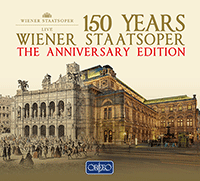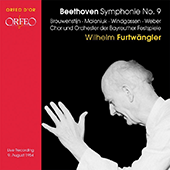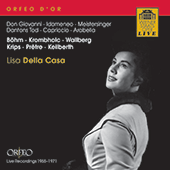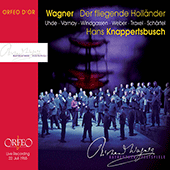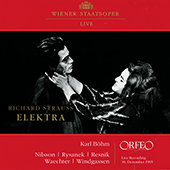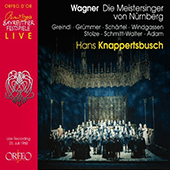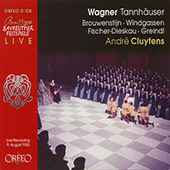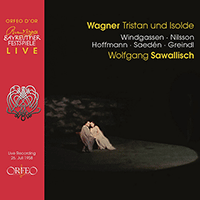Wolfgang Windgassen
Windgassen’s family had strong operatic connections: his father Fritz was a well-known tenor who served at the Stuttgart State Opera from 1923 and then taught at the Stuttgart Music High School; while his mother, also a long-term member of the Stuttgart Opera, was the coloratura soprano Vally van Osten (real name Vally von der Osten) whose sister Eva von der Osten created the role of Octavian / Der Rosenkavalier. Having commenced his vocal studies with his father, Windgassen later moved to Alfons Fischer and Maria Ranzow at the Stuttgart Music High School and made his operatic stage debut in 1939 at the Pforzheim Municipal Theatre, where his roles included Pinkerton / Madama Butterfly, Alvaro / La forza del destino and Primus Thaller / Der Kuhreigen.
After service in the German army during World War II Windgassen joined the Stuttgart Opera in 1945, remaining a member of the company for the rest of his life. Initially his parts included Tamino / Die Zauberflöte, Florestan / Fidelio, Hoffmann / Les Contes d’Hoffmann, Max / Der Freischütz and Schwalb in the 1946 German premiere of Hindemith’s Mathis der Maler. Gradually he began to tackle the Wagnerian tenor roles, singing Siegmund / Die Walküre for the first time in 1950 and making his debut at the Bayreuth Festival during the year of its post-war reopening, 1951.
For the next twenty years Windgassen was a major presence at Bayreuth, his roles including Froh / Das Rheingold (1951–1952), the title role in Parsifal (1951–1952, 1954, 1963), the title role in Lohengrin (1953–1954, 1960), Siegfried / Siegfried (1953–1958, 1960–1967) and Götterdämmerung (1953–1958, 1960–1967), Erik / Der fliegende Holländer (1955, 1960), the title role in Tannhäuser (1955, 1961–1962, 1964-1965), Siegmund (1956–1960), Walther / Die Meistersinger von Nürnberg (1957–1958, 1960-1963), Tristan / Tristan und Isolde (1957–1959, 1962–1964, 1966, 1968–1970) and Loge / Das Rheingold (1965–1969). He was made a Freeman of Bayreuth in 1967.
In addition to his work at Stuttgart and Bayreuth Windgassen sang at all the major international opera houses. He was a regular at the Vienna State Opera; made his debut at La Scala, Milan in 1952 as Florestan; at the Royal Opera House, London as Tristan and at the Paris Opera as Parsifal, both during 1954; and appeared at the Maggio Musicale Florence, the Teatro del Liceu, Barcelona, the Teatro Colón, Buenos Aires and the principal German opera houses of Berlin, Hamburg and Munich. His roles included, as well as Wagnerian parts, Adolar / Euryanthe, the Emperor / Die Frau ohne Schatten and the title roles in Otello and Rienzi. He returned to Covent Garden frequently, singing Siegfried regularly between 1956 and 1965 with Kempe, Konwitschny and Solti conducting, as well as Siegmund in 1960 with Kempe and Tristan in 1962 with Schmidt-Isserstedt at the helm.
At the Metropolitan Opera Windgassen first appeared in 1957 as Siegmund, followed by Siegfried. He did not return, however, and his only other American appearance was with the San Francisco Opera in 1970 as Tristan opposite Birgit Nilsson.
Having begun to work as a stage director from 1970, between 1972 and 1974 he served as the artistic director of the Stuttgart Opera before his sudden death as a result of a heart attack. He was married to the soprano Lore Wissmann, who was also a member of the Stuttgart company.
Windgassen’s voice was lighter than those of other contemporary heldentenors, but he was notable for his quite extraordinary vocal skill and stamina as well as his exceptional musicianship. The large number of his live recordings from the Bayreuth Festival means that he is extremely well represented on disc in addition to his landmark interpretation of Siegfried in the famous Decca/Solti studio recording of The Ring. His very considerable art is well evidenced in the live 1966 Bayreuth Festival recording of Tristan und Isolde, produced by Wieland Wagner with Böhm conducting.
© Naxos Rights International Ltd. — David Patmore (A–Z of Singers, Naxos 8.558097-100).








